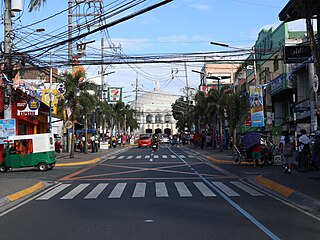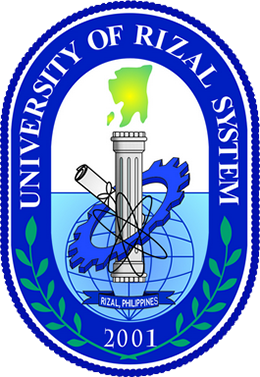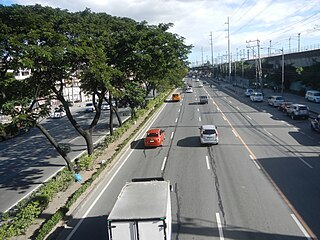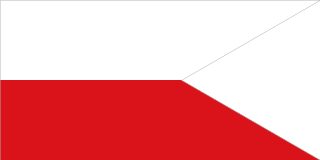
Rizal, officially the Province of Rizal, is a province in the Philippines located in the Calabarzon region in Luzon. Its capital is the city of Antipolo. It is about 16 kilometers (9.9 mi) east of Manila. The province is named after José Rizal, one of the main national heroes of the Philippines. It is bordered by Metro Manila to the west, Bulacan to the north, Quezon to the east and Laguna to the southeast. The province also lies on the northern shores of Laguna de Bay, the largest lake in the country. Rizal is a mountainous province perched on the western slopes of the southern portion of the Sierra Madre mountain range.

Antipolo, officially the City of Antipolo, is a component city and capital of the province of Rizal, Philippines. According to the 2020 census, it has a population of 887,399 people. It is the most populous city in Rizal Province and in Calabarzon region, and the seventh most-populous city in the Philippines. It is also the most populated city under the component city status.

The Philippine Revolution was a war of independence waged by the revolutionary organization Katipunan against the Spanish Empire from 1896 to 1898. It was the culmination of the 333-year colonial rule of Spain in the archipelago. The Philippines was one of the last major colonies of the Spanish Empire, which had already suffered a massive decline in the 1820s. Cuba rebelled in 1895, and in 1898, the United States intervened and the Spanish soon capitulated. In June, Philippine revolutionaries declared independence. However, it was not recognized by Spain, which sold the islands to the United States in the Treaty of Paris.

Taytay, officially the Municipality of Taytay, is a municipality in the province of Rizal, Philippines. According to the 2020 census, it has a population of 386,451 people. It is the 2nd most populous municipality in the country, after Rodriguez, Rizal. It is also known as the Garments Capital of the Philippines.

Tanay, officially the Municipality of Tanay, is a municipality in the province of Rizal, Philippines. According to the 2020 census, it has a population of 139,420 people.

Baras, officially the Municipality of Baras, is a municipality in the province of Rizal, Philippines. According to the 2020 census, it has a population of 87,637 people.

Morong, officially the Municipality of Morong, is a municipality located in the province of Rizal, Philippines. As per the 2020 census, Morong has a population of 71,151 people.

Pililla, officially the Municipality of Pililla, is a municipality in the province of Rizal, Philippines. According to the 2020 census, it has a population of 71,535 people. It is surrounded by farms, small mountains, plains, and trees. Pililla is known as the Green Field Municipality of Rizal.

The University of Rizal System (URS) is a network of colleges located in the Rizal province, Philippines. It operates multiple campuses, with the main campus being in Tanay, Rizal.

The Marikina–Infanta Highway is a 117.5-kilometer (73.0 mi) highway that connects Quezon City, Metro Manila with Infanta, Quezon in the Philippines.
The geography of the City of Manila is characterized by its coastal position at the estuary of the Pasig River that flows to Manila Bay. The city is located on a naturally protected harbor, regarded as one of the finest harbors in Asia. The scarce availability of land is a contributing factor that makes Manila the densest populated city in the world.

Juan Marquez Sumulong Sr. was a Filipino former revolutionary, journalist, lawyer, educator and politician from the province of Rizal. He was the president of the opposition party which ran against Manuel L. Quezon's Nacionalista Party in the 1941 presidential election of the Philippine Commonwealth. He is also the maternal great-grandfather of former President Benigno Aquino III.

Manila, also known as Tondo until 1859, was a province of the Philippines that encompassed the former pre-Hispanic polities of Tondo, Maynila, and Namayan. In 1898, it comprised the city of Manila and 23 other municipalities. In 1901, the province was dissolved, with the city of Manila absorbing six of its smaller neighboring municipalities. The remaining part was merged with the adjacent district of Morong to form the province of Rizal.
Eastern Metropolitan Bus Corporation or EMBC is one of the largest bus companies in the Philippines. The city operation plies routes from Antipolo, Rizal to Divisoria, Manila via Shaw Boulevard Ortigas Avenue. This bus company also offers tourist chartered and shuttle services.

The Manila East Road, also known as National Road and National Highway, is a two-to-four lane primary and secondary highway connecting Metro Manila to the provinces of Rizal and Laguna in the Philippines.
The Battle of San Mateo and Montalban was fought between the remaining Katipuneros under the command of Andres Bonifacio and Emilio Jacinto and the Spanish government after a failed attempt to capture the El Deposito water works at San Juan del Monte.

Local elections were held in Rizal on May 13, 2013, as part of the 2013 general election. Voters will select candidates for all local positions: a municipal/city mayor, vice mayor and town councilors, as well as members of the Sangguniang Panlalawigan, the vice-governor, governor and representatives for the two districts of Rizal.

Saint Jerome Parish Church, commonly known as Morong Church, is a Roman Catholic church located in Morong, Rizal, Philippines. It is under the jurisdiction of the Diocese of Antipolo. The church was built during the Spanish period in the country, with stones from a hill called Kay Ngaya; lime from the stones of the mountain Kay Maputi; and sand and gravel from Morong River.

The Battle of Sambat was the culminating battle of the first revolts of the Katipunan in Laguna. The battle was the final major action for the Katipunan chapter of "Maluningning" ending in the defeat of the rebels and martial law in Laguna province.

Local elections were held in the Province of Rizal on May 13, 2019, as part of the 2019 general election. Voters selected candidates for all local positions: a municipal/city mayor, vice mayor and town councilors, as well as members of the Sangguniang Panlalawigan, the governor, vice-governor and representatives for the two districts of Rizal.

















